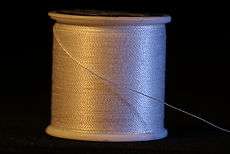Staple (textiles)

Staple refers to fibre of discrete length and may be of any composition. A continuous fibre such as natural silk or synthetic is known as filament rather than staple fibre.
Etymology
Of uncertain origin but possibly a back-formation[1] arising because part of the business of a wool-stapler was to sort and class the wool according to quality. According to Chambers Dictionary the actual word "staple" including staple foods and other products comes from the Low German word Stapel meaning a heap of goods to be sold.
Staple length

Staple length, a property of staple fibre, is a term referring to the average length of a group of fibres of any composition. Staple length depends on the origin of the fibres. Natural fibres (such as cotton or wool) have a range of lengths in each sample, so the staple length is an average. For synthetic fibres which have been cut to a certain length, the staple length is the same for every fibre in the group.
Staple length is an important criterion for spinning fibre, as shorter fibres are more difficult to spin than longer ones, so staple length varies from short to longer length fibres, short fibers also resulting in more hairy yarns.
For cotton and wool, staple length was originally tested by hand, the tester removing a clump of fibre and then arranging it on a dark cloth for measurement. In the 70s, machines were invented to do this task, taking around 5 minutes for cotton and for wool around 20 minutes. Today, machinery can take the measurement in seconds.
Filament
The opposite term is filament fibre, which is fibre that comes in continuous to near continuous lengths for use. Silk, taken from the cocoon of a silkworm, is a filament. Synthetic fibres can also be manufactured as filament. If the filament is then cut into discrete lengths, it becomes staple fibre.
Wool
See Staple (wool)
References
- ↑ "staple, n.3". OED Online. June 2011. Oxford University Press